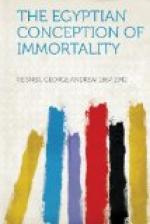It must be remembered, of course, that these traditional objects were also in use in ancient traditional ceremonies on earth. The sacrificial animals were still slaughtered with flint knives. The old-style cakes were still offered in the holy places. In other words, life on earth now consisted of ordinary material life and a traditional life—a life that clung to the forms of a more primitive civilization as somehow more effective with the divine powers. This view is closely reflected in the grave furniture; here, too, were the practical objects and the traditional ceremonial objects. Life after death is still always the same as life on earth—with the same physical needs, with the same need of help from supernatural powers or against supernatural powers. The spirit of the man needed the spirit of the copper axe to swing in battle; but just as much he needed the spirit of the flint knife to make the first cut across the throat of the spirit bull of sacrifice. Remember this—the other world, in which lived the spirit of the dead, was filled with the spirits or ghosts of all things and animals. The other, the unseen, was a duplicate of this world; all things which have shape were there —even to the black fields and the broad river of Egypt. This is the foundation of the Egyptian conception of immortality. Through all the modifications and accretions of the following three thousand years, this foundation idea is always clearly visible. All the statues, the carved and painted tombs, all the curious little model boats and workshops, all the painted mummies, all the amulets, the scarabs, the little funerary statuettes,—all this mummery which seems to be so characteristic and so essential, is only the means to an end, and an ever changing means to secure a successful comfortable existence of the spirit in the life after death,—in the ghostly duplicate of life on earth.
IV. THE EARLY DYNASTIC PERIOD
It is clear that the effort to attain an immortality which is merely a ghostly continuation of life on earth must reflect the general development of Egyptian culture,—especially the advance in arts and crafts. One of the most striking examples of this fact is the introduction of metal working mentioned above and the consequent placing of both flint and copper in the grave, —the division of grave furniture into practical objects and ceremonial objects, which is the foundation for the use of symbolic objects in later times.
The advance in arts and crafts not only suggests new ideas of the necessities of the spirit, but it provides the necessary technical skill for the more effective satisfaction of all the needs of the dead. This takes, first of all, the form of supplying a place for the burial, which furnishes greater security to the body and a better communication between the living and the dead.




